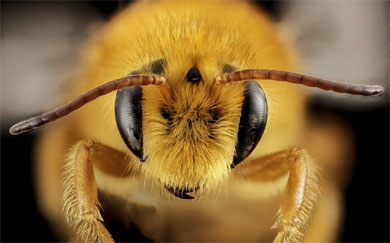By Muntadhir Abbas
25 April 2016

The Bee
In this busy and fast paced world we live in, sometimes I struggle to be able to find that illusive ‘connection’ with God, but you don’t need to look far to be stunned by His exceptional design of creation to be able to recognise and witness his majesty.
This three part piece, starting with the humble bee, seeks to look at the fascinating design of three animals. Animals after which chapters in the holy Quran are named; the bee, the ant and the spider. Unlike other chapters, such as the cow or elephant – in which the animal plays a minor role in a much more poignant central story, the three I want to explore are more cryptic titles of chapters. There must be something special therefore about each of these animals, and for me, nature is a perfect way to stimulate my mind and ponder about God.
The chapter of The Bee is number sixteen of the holy Quran, and the direct reference to the bee is in verses 68 to 69,
“And your Lord inspired the bee, saying: “Take you habitations in the mountains and in the trees and in what they erect. Then, eat of all fruits, and follow the ways of your Lord made easy (for you).” There comes forth from their bellies, a drink of varying colour wherein is healing for men. Verily, in this is indeed a sign for people who think.”
Before writing this piece I knew there were some thought-provoking facts about bees, but after some more research I have truly been blown away, and, to make easier reading, I shall share 8 insights:
1. Bees are specifically made up of either 16 pairs of chromosomes (in the case of the queen bee) or 16 single chromosomes (in the case of drones). The chapter of The Bee is the sixteenth of the Quran…go figure!
2. The verse referred to above is all in the feminine tense. Those of you familiar with basic Quranic grammar know that the Quran is very specific in its use of gender. In the world of bees, it is a female’s world. The male has no real input apart from the reproduction process. The females are the workers, builders and defenders of the hive. (Male readers alike are envying bees right about now).
3. The Quran says God inspired (Arabic word used is Wahiy) the bee, which indicates a level of intense divinity as this word usually, depicts God’s communication with holy/chosen people. This is what makes the bee stand out as an important creature to reflect and ponder over.
4. The residence of a bee, the beehive, is a true wonder in itself. In fact, the hexagonal structure, according to ancient Roman scholar Marcu Terentius Varro’s Honeybee Conjecture, is the best tessellating shape that could have been used in order to create a compact and easily replicable structure. Bee in beehive hive
5. Not only are the foods and residence of the bee something divine, but also the movement and travel. At this juncture, allow me to introduce you to The Honey Bee Waggle Dance. This phenomenal dance like movement allows a bee to communicate the whereabouts of pollen to its fellow hive-dwellers. The figure-eight dance first maps the bearing, coupled with an internal clock tuned to the horizon, to allow a definitive angle to be calculated. The time spent ‘waggling’ gives a proportional distance to the treasure chest of pollen, with the possibility that releasing pheromones signals the quality and availability of the pollen. This divine spectacle is summarised in the video below (guaranteed to blow your mind!):
6. After all the waggling and building, the bee produces a sweet elixir which in itself is a wonder; honey. With it’s use as a home remedy, sweetener, natural wound healing agent as well as for beauty and therapeutic applications, honey is a miracle from the belly of the bee.
7. The verse of the Quran states the drink (honey) comes in varying colours, which as we see today is true. Honey can be obtained in numerous colours including gold, amber, red and bronze. This range in colour is down to the varying flowers from which the bee extracts its pollen, which also contributes to the intensity and flavour of the honey.
8. Worker bees tend to live up to 6 weeks, whilst the queen will live for up to 5 years, and she tends to lay 2500 eggs a day. In addition, a hive of bees will fly 90,000 miles, the equivalent of three orbits around the earth, to collect 1 kg of honey.
More facts about the bee could be spoken about, but I’m sure you’ll agree that, for a creature roughly the size of a thumbnail, the bee is remarkable and unique in design. Pondering over creations like the bee often allows me to feel God (through the heart and soul), and open up a conversation with Him and admire His unparalleled wisdom and design. It is this awe that leads me to humble myself in front of the exalted one who gives life to, and nourishes, every one of His creations.
There is thus a clear argument in this that the exactitude in skill and ingenuity is not due to the bee but due to the Omnipotence of Him, Who has created it on such pattern and appointed it to the service of mankind.
– Tawhid al-Muffadhal
Source: themuslimvibe.com/faith-islam/in-theory/animals-in-the-holy-quran-the-bee




 Moderate Islamist here
Moderate Islamist here


0 comments:
Post a Comment